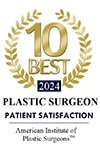Epistaxis, or nosebleed, although a common occurrence, can be alarming. The great majority of nosebleeds, however, are not cause for serious concern. Most people experience one or more episodes of epistaxis during their lifetime, usually during cold, dry weather. While a nosebleed can occur to a person of any age, epistaxis most frequently occurs in young children and older adults. If an individual has frequent nosebleeds, however, or if a nosebleed is severe, the patient should be examined by a physician to make sure the that there is not an underlying condition that requires medical attention.
Types of Epistaxis
Nosebleeds are categorized according to their point of origin in the nose. Anterior epistaxis accounts for 90 percent of nosebleeds and is easily controlled. Posterior epistaxis is far less common and may be more complicated to treat. Posterior epistaxis tends to occur in elderly individuals and may require the care of an otolaryngologist or even necessitate a hospital admission.
Causes of Epistaxis
There are a many reasons for epistaxis, some common and some quite rare. Very often, a combination of factors may lead to a nosebleed. Certain causes may be more frequently observed in patients of a particular age group.
Common Causes of Epistaxis
- Dry air, especially dry cold air, that dries out nasal membranes
- Allergies, colds, or sinus infections, resulting in frequent nose blowing
- Nose picking
- Traumatic injury to the nose
- Blood thinners or hypertension medications
- Inhaled chemical irritants or illegal drugs, such as cocaine
Less Frequent Causes of Epistaxis
- Hypertension
- Anatomical abnormality of the nose
- Hemophilia or other bleeding disorder
- Nasal or facial surgery
- Nasal tumors
- Leukemia or Hodgkin's Lymphoma
While is is best to assume that a single nosebleed is not a cause for concern, it is important to be aware of the more remote serious implications if nosebleeds recur.
Symptoms of Epistaxis
Epistaxis is, of course, a symptom itself. Normally, the bleeding occurs from only one nostril, but if it is heavy enough, the other nostril may also bleed, or the patient may spit, or even vomit blood.
Symptoms of epistaxis that require medical consultation include:
- Blood in the urine or stool
- Frequent bruising
- Inability of the blood to clot
Patients who have a known disease condition or are undergoing chemotherapy should consult a physician if they experience a nosebleed. Emergency medical care is required if a patient experiences a nosebleed accompanied by:
- Lightheadedness, dizziness, or fainting
- Tachycardia or difficulty breathing
- Coughing up or vomiting blood
- Rash or fever
Repeated nosebleeds during a short period also require immediate medical care.
Diagnosis of Reasons for Epistaxis
In order to determine the cause of the nosebleed(s), the doctor uses a topical anesthetic to numbs the inside of the nose. This medication also constricts local blood vessels and reduces swelling. Blood tests will also be administered to evaluate the effect of any blood thinners in the system, to see how much blood the patient has lost, and to look for any abnormalities in the blood or any underlying disease conditions.
Treatment for Epistaxis
There are a few simple home remedies for nosebleeds that are generally very effective. When medical intervention is required, packing may be involved.
Home Treatment for Epistaxis
The following tried and true treatments for simple anterior nosebleeds are, most often, all that is required for a simple episode of epistaxis:
- Lean the head forward while sitting straight
- Pinch the nostrils together for 10 minutes
- Spit out any blood in the mouth
- Avoid sneezing or nose blowing for 24 hours
- Avoid strenuous exercise or heavy lifting for a few days
Methods that are not helpful for nosebleeds and, in fact, may make them worse, include leaning the head back and applying ice packs.
Medical Treatment for Epistaxis
The first line of defense the doctor has for epistaxis is to cauterize the affected blood vessel in order to seal it shut. This is usually only possible for anterior nosebleeds. Packing with petroleum jelly on gauze, which applies pressure to the affected blood vessel, may be used for either anterior or posterior epistaxis.
In more serious cases, where a posterior nosebleed requires hospital admission, a balloon or sponge pack may be employed. Since this type of packing prevents normal sinus drainage, is very uncomfortable, and carries a risk of infection, the patient may be given some combination of analgesics, antibiotics, and sedatives. These packings usually remain in place for 2 to 3 days.
If a medication or illegal drug is causing the problem, the doctor will make medication changes as needed, or help the patient seek help for the addiction. If other conditions are discovered, medication, radiologic procedures or surgery may be necessary.
Prevention of Epistaxis
The most common types of epistaxis can, in many cases, be prevented. Some effective methods of becoming less prone to nosebleeds are:
- Humidifying the air
- Using petroleum jelly, nasal lubricant or saline spray in the nose
- Avoiding picking the nose or blowing the nose too hard
- Avoiding smoking or being in a smoky environment
Even though not all nosebleeds can be prevented, with a little foresight, many can.


